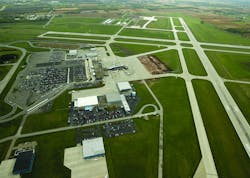Appleton, WI - The Fox Cities of northeastern Wisconsin includes the county seat of Appleton, situated on the Fox River some 100 miles north of Milwaukee. Owned and operated by Outagamie County, the Outagamie County Regional Airport (ATW) now operates a new FBO, Platinum Flight Center.
Comments airport director Marty Lenss, "We are now directly involved with the fuel pricing here at the airport for a number of reasons. We are certainly in the business to garner a profit; the Outagamie Airport is self-sufficient.
"Like most businesses in the last couple years, we experienced financial stress and had to find different ways of creating revenue.
"In a high regulatory environment that adds expense … whether it’s security, or FAA and safety, or environmental … you don’t have to be in this business long to get an appreciation for how regulated it is. We have to identify new sources of revenue; certainly fuel is that."
A new FBO terminal is a priority here, and the airport hopes to break ground on a facility that is now in design sometime next year. With a location ideal for GA overflow from EAA's AirVenture, an annual aviation mega-event held in Oshkosh, WI some 25 miles from ATW, plans are in place to revitalize general aviation and spur economic growth for the region.
Background
The previous FBO's lease with the County expired in 2005, relates Lenss. From then until 2008 lease amendments with one-year extensions were added to allow the FBO to operate. In 2007, the County began looking at putting out an RFP (request for proposal) for FBO services.
The RFP was issued and the initial response was found to be non-responsive; a second RFP was issued in 2008 … there were three respondents. During that time, airport leadership changed.
"We started some initial discussions regarding the RFP … what happened was in ’08 and ’09 when the economy was south, that interrupted the financial ability of potential investors," explains Lenss.
"We as a County backed up and reviewed our options given the new reality and the new economy."
One option was to move the FBO into a proprietary-exclusive scenario, which is an option under FAA grant assurances, but the option has to be exercised by using airport/county employees. That was something that really didn’t take hold, says Lenss.
"We felt strongly that we wanted to turn general aviation around," he adds. "We wanted to be active participants in the process, and mutually align the airport’s and the FBO's interests. We want to share in the success, and if the FBO had stress, we wanted to share that stress … to be a full partner in the process versus the traditional landlord relationship."
Around 2007, the airport embarked on some $7 million in investment in the south general aviation area with expanded infrastructure in ramps, taxiways, fiber, power, sewer, water, access roadways, and landscaping. The goal is to provide a first-class impression for private aircraft operators arriving in the Fox Cities, relates Lenss.
"It also separates our FBO operations from our commercial operations … we have some safety and security advantages to do that," he adds.
"That investment has been sitting somewhat underutilized … the FBO hasn’t made that final move to the southside. We felt in order to kickstart that investment in development in the facilities and a self-fueling operation, we should get involved."
The solution the County liked and has taken was that of a contract-management approach. It repackaged the RFP into an RFQ (request for qualifications), and had an overwhelming response. "That was our first indication that we might have something," says Lenss.
"Other airports have done this. It’s a bit unique in this application, but we felt like this had some potential; it gave the county the ability to spur investment and take a managed-risk approach."
At the conclusion of the contract term all options are open to the County. Says Lenss, "We can go back to the traditional model, continue the existing model, or continue to explore a proprietary-exclusive. It was a good middle-ground as we saw it to kickstart that investment and move the ball forward with developing GA and the private aircraft arena here."
Express Airport Services (EAS) was selected to operate the new FBO; its partner on the RFQ is Tailwind, a flight training school and Cessna Pilot Center. Neither of the companies were tenants before the contract.
Express Airport Services (EAS) at the time was a fully-owned subsidiary of ExpressJet Regional Airlines (operates United/Continental regional flights from ATW). FBO operations began in October 2010 and the company fuels GA and the commercial carriers here, but does not perform airline ground handling, says Platinum Flight Center general manager William Zejda. "We’d love to explore that piece of business with the carriers here; we do some ground handling for air charters," he says.
At the time of negotiations, says Lenss, "We were approached by our incumbent operator to enter into negotiations for an asset purchase and acquiring a large corporate hangar and attached fuel farm [long-term lease associated with the facility].
"We purchased the remaining lease term and the assets, including fuel trucks, tow-bars, tugs, fuel farm and deicing equipment, etc., from the incumbent.
"We acquired the hangar asset and fuel farm asset and we are now just concluding our new fuel farm project; it will be operational just before EAA AirVenture in late July and includes self-fueling capability - something our resident pilot population has asked for."
Benefits; activity level
The FBO transition was conducted in a very compressed timeframe, says Lenss. "We worked with EAS and Tailwind to come up with a new name for the facility, Platinum Flight Center, as well as making some minor cosmetic changes to the existing FBO facility.
"The physical facility was in rough shape; much like a commercial terminal, it’s often times the first and last impression that pilots get when coming to the community.
From a fueling standpoint, comments Lens, "We felt like this model made a lot of sense; we are taking those proceeds from the FBO and fueling and reinvesting back into the infrastructure to hopefully spur a healthier more robust aviation community here at the airport."
It also has advantages in other areas of lease negotiation. The initial lease term for the FBO is five years plus a few one-year options.
Says Zejda, "The biggest benefit for the airport will be in controlling the product. Now the airport has more control over the face of what they are presenting to general aviation here.
"The entire goal in getting this contract is customer service ... putting the right people in the right places and giving the customer that platinum-level of service."
The FBO currently has 18 employees, and Zejda does not expect to add employees once the FBO moves to the southside of the airport. "Overall, it’s going to be a much more compact operation, with everything in a common area on the field," he adds.
Activity here has been pretty steady of late; officials have seen an uptick. "Our core business is the business traveler," relates Zejda. "We are expecting to bring in new corporate activity; already there have been some changes made and people want to come back here now … and I don’t know if they had that feeling before."
The airport has been an unbranded facility for quite some time, relates Lenss. It's currently evaluating the branding process; the airport has a say in the fuel brand supplied and has issued an RFP.
Features; AirVenture effect
The general build-out of the new FBO terminal along with a common aircraft storage hangar and a new maintenance hangar is under design. "That is kind of the last element of our master plan in moving general aviation from next to the commercial passenger terminal and getting it to the southside … that would then allow growth to occur by not having conflicting land use issues between commercial aviation and GA," explains Lenss.
Part of the airport’s initiative as a whole relates to sustainability, and its looking at a variety of design options for the terminal to include some sustainability measures such as solar, geothermal, daylighting, etc.
The airport will fund the development, and there are also some hangar funding opportunities with the Bureau of Aeronautics.
On EAA's AirVenture, comments Lenss, "We are certainly and overflow airport for EAA. On a typical year we will see some 450 GA-related unique aircraft visits to the airport.
"Last year, because of all the wet weather, we had more than 700 unique aircraft. In the south GA area, we’ve actually developed three grass fields for parking aircraft; those are designed to drain quickly and really paid dividends for us last year."




